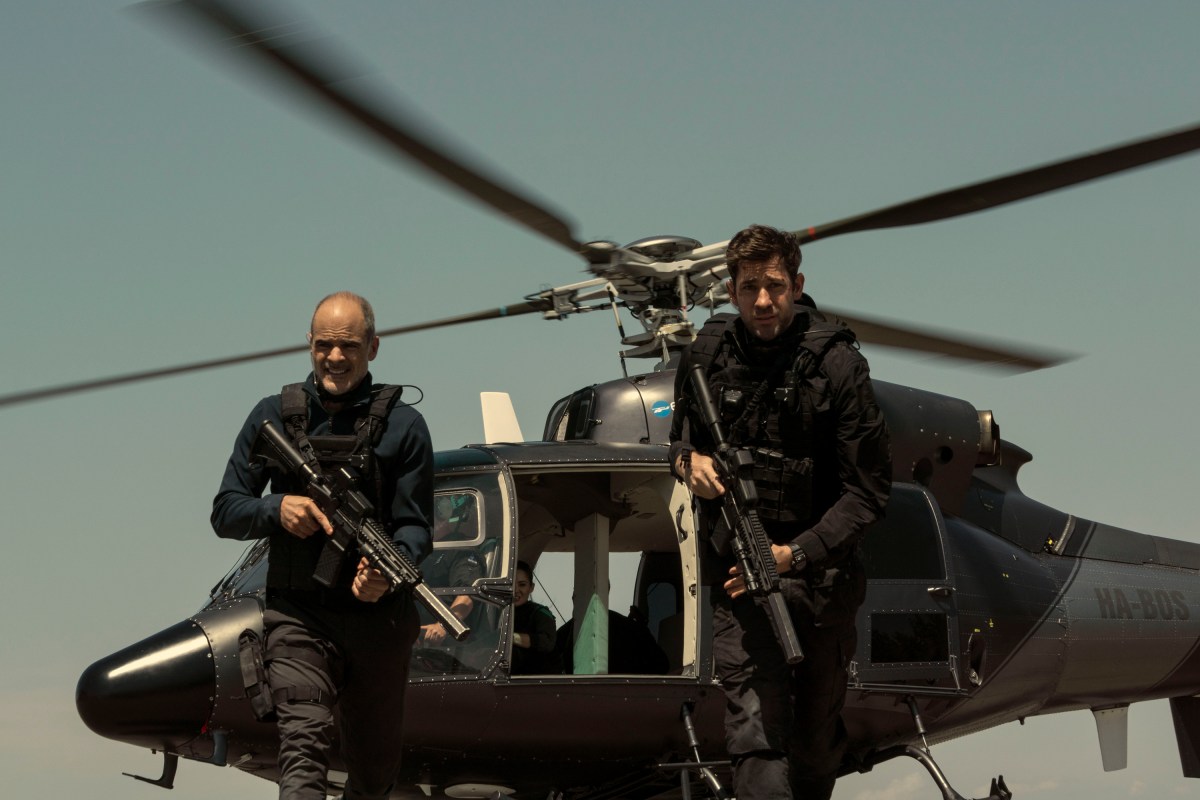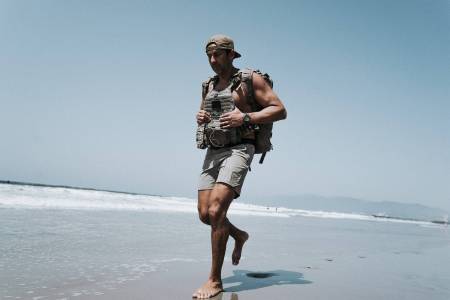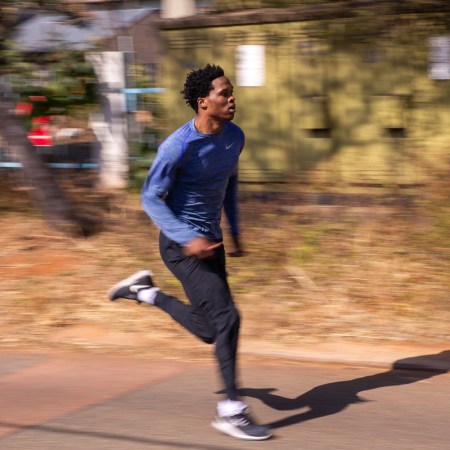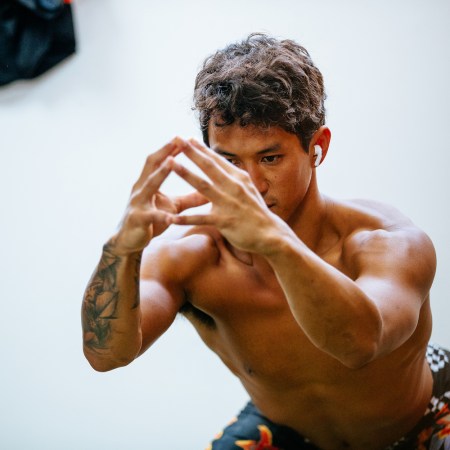Before finding his way into show business, Navy SEAL Kevin Kent did 21 years of active duty, including multiple combat deployments with SEAL Team Five and several years as an instructor at BUD/S.
As a mentor to future SEALs, few people are more qualified to help train actors through the responsibility of playing a special forces operator. Fortunately, following a few surprising life events, Kent ended up at the side of John Krasinski. He was there to shepherd the actor through his impressive transition fromThe Office‘s lovable goof to an action hero in 13 Hours and Amazon Prime Video’s Jack Ryan.
We spoke with Kent about that journey, working with Michael Bay, pushing Krasinski out of a helicopter (for a scene, relax) and what it takes to bring authentic action to the screen.
Before work on Jack Ryan, how familiar were you with the character and the works of Tom Clancy?
I’d read a good number of Tom Clancy’s books in my earlier years, with Without Remorse — which is about a Navy SEAL — being one of my favorites. I’d also seen all of the movies, including The Hunt For Red October and Clear and Present Danger.
I know before Jack Ryan began, you had worked with John Krasinski on Michael Bay’s 13 Hours. What was it like helping him prepare for that military thriller?
I ended up on that movie thanks to Harry Humphries, who was also a Navy SEAL and has been a military advisor on many Michael Bay films, all the way back to The Rock. Harry and his wife Catherine have helped a good deal of veterans start their second careers in show business, myself included. For 13 Hours, Bay wanted to run the actors through a boot camp, so I helped set up a two-week training experience in Southern California before they started filming.
There was a group of us SEALs who would run them through PT in the morning, then hit drills and gun work on the range. Once we started filming principle photography in Malta, we continued working with them during those months as well. We ramped up the training when there were scenes that John and the other main guys had to move as a real squad. During those months, he and the rest of the cast learned a great deal.
Once you were brought aboard Jack Ryan, what were your thoughts and goals?
I was excited to get handed the opportunity, again thanks to Harry and Catherine, who were busy with another project. I remember when my friends and strangers heard I was working on the new Jack Ryan series, they would ask me who was playing the main character. And when I would say John Krasinski, the people who only knew him from The Office would raise their eyebrows. But if they saw 13 Hours or if I told them about what we had done, suddenly everyone got it.
For me, the goal is always to make the actors as comfortable with the real weapons and tactics as possible. The producers Allyson Seeger, Andrew Form and John Kelly have always been great about making sure I have as much before time with the actors as I need. The tenets that we stress are shoot, move and communicate. Our goal is for the action to come to them easily and without thought, so that they can concentrate on the acting. The last thing we want is for them to kick themselves for messing up a magazine change and have that be a reason they mess up their line.
How did you approach getting Krasinski ready for this particular role?
For the gun training, or for anything else we do that is that crucial, we crawl, then walk, then run. I’m not just going to hand a guy an assault rifle and let them run off with it on the range. My last few years in the military I was a BUD/S instructor, getting guys ready to be SEALs. So I have experience dealing with people of all skill levels and all kinds of weapons. John was coming off of 13 Hours where we had worked with all kinds of rifles, like the M240, Mark 46 and M249 Bravo.
During our training sessions, we go through concepts like low ready or high ready positions. Over and over again. Bringing your weapon to your shoulder, your gun to your head, rather than your head to the gun. Doing things like that, so that your picture stays clean rather than distorted. Perfection is required before we start to fire rounds. For this role, the Jack Ryan he plays is a former Marine, so he has the expertise but isn’t a polished pro at the time we find him in the show. John played basketball and crewed in school, so he has athletic ability, and we leaned on that as he develops in the series.
Do you remember the first scenes that you filmed for the series?
The first thing we did was assemble a group of forces guys and fly out to Montreal. There we worked on the scenes you see with the French SWAT guys where quite a few people get blown up in a Paris flat. From there, we went to Paris and Morocco. That was the first real shoot we did for the series, and it was a blast. During the beginning of the first season, Jack is just starting to get his feet wet. He’s coming in as an analyst, and we see him start to get into the fray from there.
By the time John was starting on Jack Ryan, he had a lot of experience with weapons at that point, and was coming off of 13 Hours where there were a lot of guns. Because his backstory includes a military past, we were able to wink and use that experience. There is a scene in the first season where Jack is in a French armored car with Matice, right before they hit this house. Matice kind of tosses Jack a pistol and tries to explain how it works, thinking he doesn’t know what to do.
John asked me what his character would do in that situation. I told him that because Jack is a former Marine, he would be comfortable enough with the pistol and perhaps would do a press check, looking for a round in the chamber. John was able to do it easy, and it became a great little scene between Matice and Jack, where he press checks and de-cocks the gun. There is a look of respect that comes from Matice after that.
Navy SEAL Kaj Larsen’s Guide to Becoming a Better Swimmer
The best waterman in his class talks dolphins, breath exercises and something called “surf torture”Every season, the scenarios and situations escalate, which brings a lot of excitement to the action. And Ryan finds himself often overwhelmed, true to the character in the books.
I have really enjoyed the arc of this character. There are some great moments when Wendell Pierce as James Greer is pushing Jack Ryan deeper and deeper into the field. Everyone seems to be pushing him further, and in these scenarios he needs to bring out that soldier. He’s doing all this sleuthing and spy work, but when push comes to shove, he has to join in the fray. This is a man who has a background but is in over his head and has to really refine his craft.
One of the bigger sequences, like that came at the end of season two where Ryan and a team of mercenaries joins up with Mike November, played by Michael Kelly, for an assault on a palace in Venezuela.
The great thing about the second season was how it escalated for Jack, starting off with him avoiding the gun fights around the containers. Eventually his team has to fight their way out of the jungle, and he links up with Mike November. That’s when they go to the palace for the huge gun fight in the finale. The location that we filmed the palace scenes was in Colombia, and it was being renovated, so we were able to do whatever work we wanted in there for several weeks. Everything was getting destroyed.
John threw a hand grenade with perfection in that scene. Is that something that you drilled as well?
It’s funny that you bring up the hand grenade scene because the shot that we used was the very first one of the day. John had experience throwing crash grenades during 13 Hours, so we had drilled it a lot. In Jack Ryan, John was supposed to throw a hand grenade from behind a pillar. I told him to pull the pin, flip the spoon, give the charge some time and roll the grenade towards the bad guys. John hit the mark perfectly that we had put down for the cameras. The director looked up to me and said, “You are training this guy good.” I said that I couldn’t take all of the credit because he brought some natural ability.
How do you go about building a scene like that?
I work very closely with the stunt coordinator Jordi Casares. I respect the stunt team’s craft as much as they respect my craft, and the lines of communication go both ways. They will draft out how an action scene might go and share what we need to make happen, then ask for my guidance. I’ll then say what parts we might need to adjust, or suggest another idea if we have someone in our crew that has other abilities that could be utilized. I can step in whenever to tell them what strategies I might take in that instance.
Once you are filming, what level of communication do you have with the cast?
The cast, including John, will come to me often and at any point as we’re filming. Everything down to the way they walk, where the finger should be on the gun, when we have them on the trigger or where they would be looking tactically. I’ll also look over the dialogue to help them make sure that during those tactical moments, they are speaking correctly, using things like MGRS, or military grid reference system, for locations. Between takes, I’ll occasionally give insight if they should change their weapon behavior or just adjust it. Because we have drilled these things so many times and they have heard the lingo for so long, I don’t need to say much for them to correct themselves.
You make an appearance onscreen in season three. How did that come about?
During our time training together and helping John build the character, I shared a story about a nighttime boat assault that we did when I was in the SEALs. John had remembered the story and used it to build a scene that ended up in the first episode of season three. I remember I was out of town, on another project, when John first texted me saying he wanted me to play one of the commandos in the scene.
I was on set at the time, and I think I just texted back something like, “Sounds good.” I don’t think it appropriately showed how glad I was to do the role because John texted, “Geez, I thought you’d be a bit more excited.” That’s when I had to hit him back and make sure he knew how stoked I was! I went back out to Budapest and stayed until the end of the show. The scenes that we did in the interior of the ship were in Budapest, which was me, John, RJ Casey and Paul Thomas. We choreographed the whole thing there on set.
The boat sequence is super exciting and a great way to kick off the season. What else went into making it look as legit as possible?
The exteriors were done in Greece. The ship was docked and pier-side the whole time, which is a huge credit to our production team because everyone watching the show believes the boat was underway. We had two days for rehearsing before filming us climbing up the side of the boat. There is a line that pulled us up the boat, and that’s how we get back down after the operation. We worked out all of the kinks with John’s stunt double. On the day that we were going to start filming, John just rolled up, put the gear on and clipped the rope in. It was a bit sketchy — we were around 40 feet off the water line. John didn’t blink twice, he just clipped in and started to walk up.
There is another great scene where you actually throw Krasinski out of a helicopter.
That was a great day. We were rehearsing with John’s stunt doubles, unbuckling them in the helicopter and then tossing them somewhere over 20 feet or so into the water. Once we were ready to film, and John got in the bird, I turned to him and said, “Are you ready to do this?” He said, “What do you mean?” The original plan was just for him to film everything before he gets tossed out of the heli. I may have been goading him on, but I started saying how much better it would look if he was tossed out into the water instead of the double.
In the SEALs, we have something called a “hooyah day” where we are just looking to push the envelope and have fun. Hooyah can mean a lot of things in the SEALs, and we leaned into it on that day. I think it helped that John heard me and the other military advisors say we’re jealous that we weren’t able to jump ourselves. A little peer pressure can go a long way. I guess I leaned into the scene and really sold it because John came to me after and said, “Dude you scared the shit out of me.”
The scene came out great though, and it’s a testament to John and the work we get to do on this show. Every precaution is taken, everything is rehearsed many times over, but there is adrenaline involved, and that is what we want the audience to feel from the screen.
The Charge will help you move better, think clearer and stay in the game longer. Subscribe to our wellness newsletter today.

























